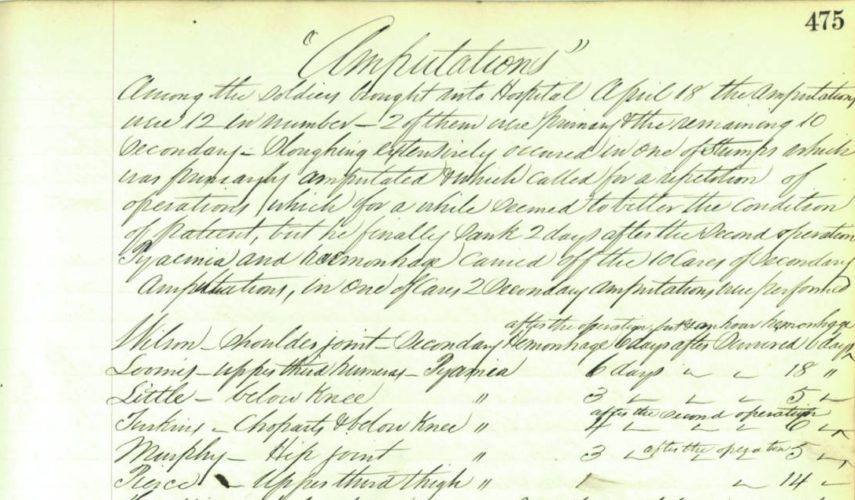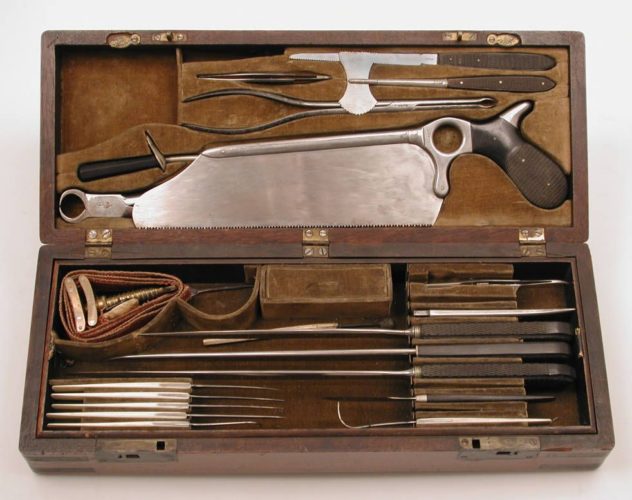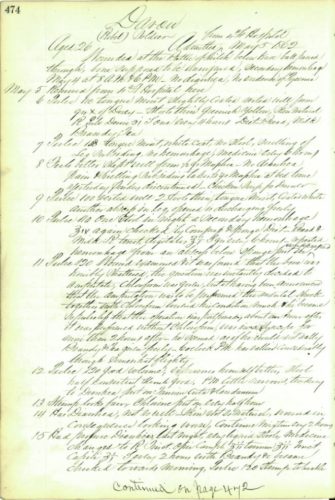St. John’s Hospital and the Sisters of Charity of Cincinnati

This past summer, the Sisters of Charity of Cincinnati archives was able to digitize excerpts of a Civil War-era patient ledger thanks to an Ohio Archives Grant received from the Ohio Historical Records Advisory Board. The collection is now available through Ohio Memory and we’re excited to provide some context to the institution from which the ledger emanated, along with the role the Sisters of Charity of Cincinnati played in these soldiers’ lives.
Quickly following the founding of the Sisters of Charity of Cincinnati in 1852, St. John’s Hospital opened on November 13, 1852, in Cincinnati, at the corner of Broadway and Franklin (Woodward). Five Sisters of Charity of Cincinnati managed the 21-bed facility. Three years later, in 1855, the hospital was moved to Third and Plum, to buildings that formerly housed an academy and an orphanage. Here they accommodated 75 beds in the two buildings. During the Civil War years, most of the beds were occupied by wounded soldiers for whom St. John’s received no government aid. In 1866, the hospital moved to Sixth and Lock Streets and was thereafter called Good Samaritan Hospital, which continues to serve the greater Cincinnati community to this day.
“McWimer soldier – Age 18; admitted April 18, 1862 – Was wounded at Battle of Pittsburg Landing in elbow; exsection was performed day before he came to house and was brought in much prostrated; wound offensive and mortifying” (Page 463)

Sister Anthony O’Connell’s name is synonymous with St. John’s Hospital and Good Samaritan Hospital. In her book, The Sisters of Charity of Cincinnati in the Civil War: The Love of Christ Urges Us, Sister Judith Metz documents Sister Anthony’s service at the Battle of Shiloh as well as on the “floating hospitals” that would eventually send soldiers to St. John’s Hospital:
“Sister Anthony O’Connell… left Cincinnati for Shiloh, accompanied by two other Sisters of Charity; Dr. Blackman of Cincinnati; Mrs. Hatch and daughter; Miss McHugh; Mrs. O’Shaughnessy and some charitable ladies of the Queen City. […] In a soldier’s diary, the following tribute is made to Sister Anthony: ‘Amid this sea of blood she performed the most revolting duties for those poor soldiers. She seemed like a ministering angel, and many a young soldier owes his life to her care and charity. Happy was the soldier who, wounded and bleeding, had her near him to whisper words of consolation and courage. She was reverenced by the Blue and Gray, Protestant and Catholic, alike; and was conferred on her the title of the ‘Florence Nightingale of America.’ Her name became a household word in every section of the North and South’…. In Otto Juettner’s Daniel Drake and His Followers…, we learn more about this high regard for Sister Anthony. ‘From the group of these heroic women, who worked in the interests of the highest and purest form of humanity, Sister Anthony stands out in bold relief. To the soldiers of both armies her name had a magic ring of wonderful power…. She stood bravely and attentively at the side of George Blackman, helping him in his operative work on deck of one of the ‘floating hospitals’ on the Ohio River.”
Last year, Sister Anthony’s medical bag was featured in an issue of Intercom, the official newsletter of the Sisters of Charity of Cincinnati. Click here and scroll to page 26 to read more about this artifact and its connection to the Battle of Shiloh.

The excerpts digitized from this ledger serve as a physical demonstration of the journey of these soldiers from their emergency treatment on the Tennessee battlefield, by the Sisters in many cases, to their continued care up the river on converted steamboats that served as floating hospitals on to their final destination of St. John’s Hospital in Cincinnati.
“Love- Rebel soldier – Admitted April 18, 1862 – Wounded at the Battle of Shiloh, the ball entered thigh; shattered the neck of femur…the whole limb in enormously swollen but swelling is not painful; has been taking quinine 2 gm (?) and a pill of opium – subminal hydrang (?) every 3 hours with benefit – May 2 – Had a chill; medicine continued – May 3 – Much pain in limb & abdomen above; acts as if neuralgic; a cataplasm did not relieve it; Put on a chloroform stinct aconite with but temporary relief” (Page 469)
Many patient ledgers from this time serve more as case studies or “charts” when compared with similar ledgers from the late 19th and early 20th centuries. This patient ledger includes, whenever possible, the name, date admitted, nativity, and affiliation (i.e. Union or “Rebel”) for each soldier admitted to the hospital. This extreme detail humanizes the patient and delves into the stages of their treatment and surgical needs. Thanks to the painstaking efforts of Sister Joyce Brehm, a faithful volunteer of the archives, each entry of the ledger that has been digitized now includes a keyword-searchable transcription. Given that many of the medical diagnostic terms and drugs mentioned (some noted in abbreviated form) have fallen out of the lexicon, this was no easy feat! Although researchers will encounter some question marks in the text field, over 80 percent of the text has been transcribed.
For more information about the Sisters of Charity of Cincinnati archives or to schedule an appointment to view more materials from our Civil War collection, please visit http://srcharitycinti.org/contact.htm.
Thank you to Veronica Buchanan, Archivist with the Sisters of Charity of Cincinnati, for this week’s post!



Leave a Reply
You must be logged in to post a comment.